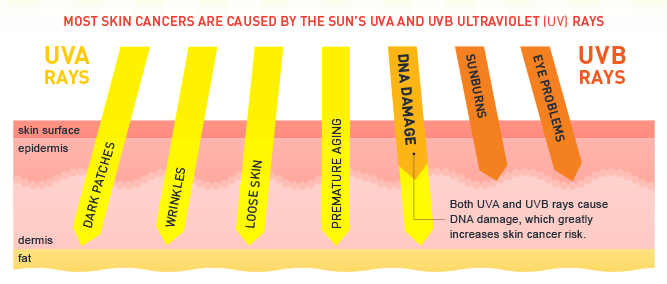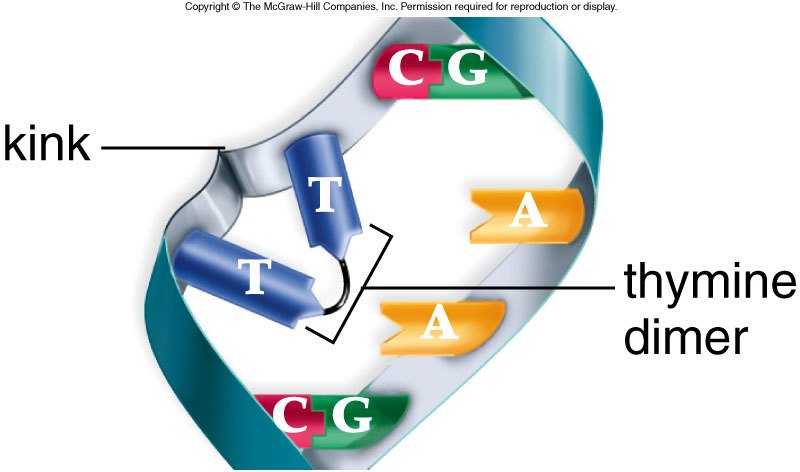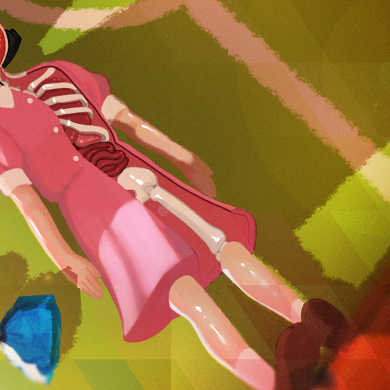By Nicki Guivatchian | UTS Staff Writer | SQ Online (2015-16)
Next time you visit La Jolla Shores, you may want to rethink that tanning session; the risks associated with achieving that golden tan may not be worth it after all. Sun exposure is the number one cause of skin cancer. With about 3.5 million diagnoses each year, skin cancer is the most common cancer in the United States.
Most types of skin cancer are caused by the sun’s UVA and UVB rays, both of which are short-frequency, ultraviolet photons that can generate free radicals, damage your DNA, and cause premature aging by breaking down the supportive connective tissue in the dermis. Both types of rays can cause damage to DNA in your skin cells, which greatly increases your chance of getting skin cancer.

Skin cancer develops in the epidermis, the top layer of skin, which both UVA and UVB rays can penetrate. When the rays penetrate through the nucleus of your skin cells, they can cause neighboring thymine DNA bases to attach to each other, forming a thymine dimer. If a cell has many thymine dimers, it will commit apoptosis or programmed cell death and the resulting skin cells will peel away as a means of ridding the body of these potentially dangerous cells. The body has cellular machinery to correct errors in DNA by replacing the dimers, but if the cell becomes overtaxed it either commits suicide or divides uncontrollably to form a tumor. The production of melanin, which is responsible for the desired golden tan color, is initiated to absorb the rays to protect cells from the damaging radiation. If there is too much genetic damage to these dermis cells, however, the chances of the cell spotting and correcting the thymine dimers decreases.

Given the risks of exposing your skin cells to the sun, using the most effective sunscreen is essential for your health. When shopping for sunscreens, most people merely glance at the SPF value to decide what amount of protection they would like. SPF, or Sun Protection Factor, is actually only a measure of UVB protection to prevent sunburns – it cannot stop the more common UVA photons from penetrating the skin. Thus, your sunscreen is not necessarily protecting you from all of the harmful rays emitted by the sun. For protection from UVA rays, sunscreen should include inorganic chemicals that reflect UVA light, such as zinc oxide and titanium dioxide, and organic chemicals, such as avobenzene, that can absorb and dissipate this radiation as heat. Reapplying sunscreen is also vital, as many of these organic chemicals work by breaking down as they absorb UV light over time. The recommended amount is a shot glass full of sunscreen every two hours, depending on how much sun and water exposure you have. It should also be applied 30 minutes before sun exposure so the skin can absorb it.
When shopping, make sure to choose a broad-spectrum protection sunscreen with an SPF above 30 (which blocks 97% of rays) that includes the inorganic compounds that can absorb and scatter UVA rays. The term “broad-spectrum” refers to the sunscreen’s ability to protect against both UVA and UVB rays.
Some people seek that golden glow without help from the sun, but the tanning bed is not a safe option either. Tanning beds still deliver dangerous UVA and UVB rays as they cause the skin cells to release melanin, which is a sign of DNA damage. Under the Affordable Care Act, there is a 10% additional tax for using tanning salons, which was supposed to reduce the number of people risking their health in tanning beds. However, the tax, which was implemented in 2010, has not actually significantly reduced the number of customers in these tanning salons.
With skin cancer cases in the United States increasing every year, think twice before hitting up Black’s, Scripps, or La Jolla Shores for the perfect bronze without broad-spectrum sunscreen. Avoid the unnecessary risks and embrace your natural skin color!
[hr gap=”0″]
Sources:
- http://www.cancer.org/research/infographicgallery/skin-cancer-prevention?gclid=CjwKEAjwtr6sBRDv7uzB492H9XISJADj6aqbeuAP0zdUSBR6EMIM-jkD3C4eboQDNmRSwSREipWr_BoCKajw_wcB
- http://www.dermalogica.com/what-is-a-sunburn%3F/ys_skinaging_4,default,pg.html
- http://genetics.thetech.org/ask/ask402
- http://www.scientificamerican.com/article/how-does-sunscreen-protec/
- http://www.scientificamerican.com/article/how-does-ultraviolet-ligh/
- http://www.compoundchem.com/2014/06/05/sunscreenchemicals/
- http://www.melanomafoundation.org/prevention/facts.htm
- https://www.aad.org/media-resources/stats-and-facts/prevention-and-care/sunscreen-faqs
- http://money.cnn.com/2012/06/28/pf/taxes/tanning-tax/
- http://www.cdc.gov/cancer/skin/basic_info/indoor_tanning.htm
- http://www.mayoclinic.org/diseases-conditions/wrinkles/basics/causes/con-20029887

